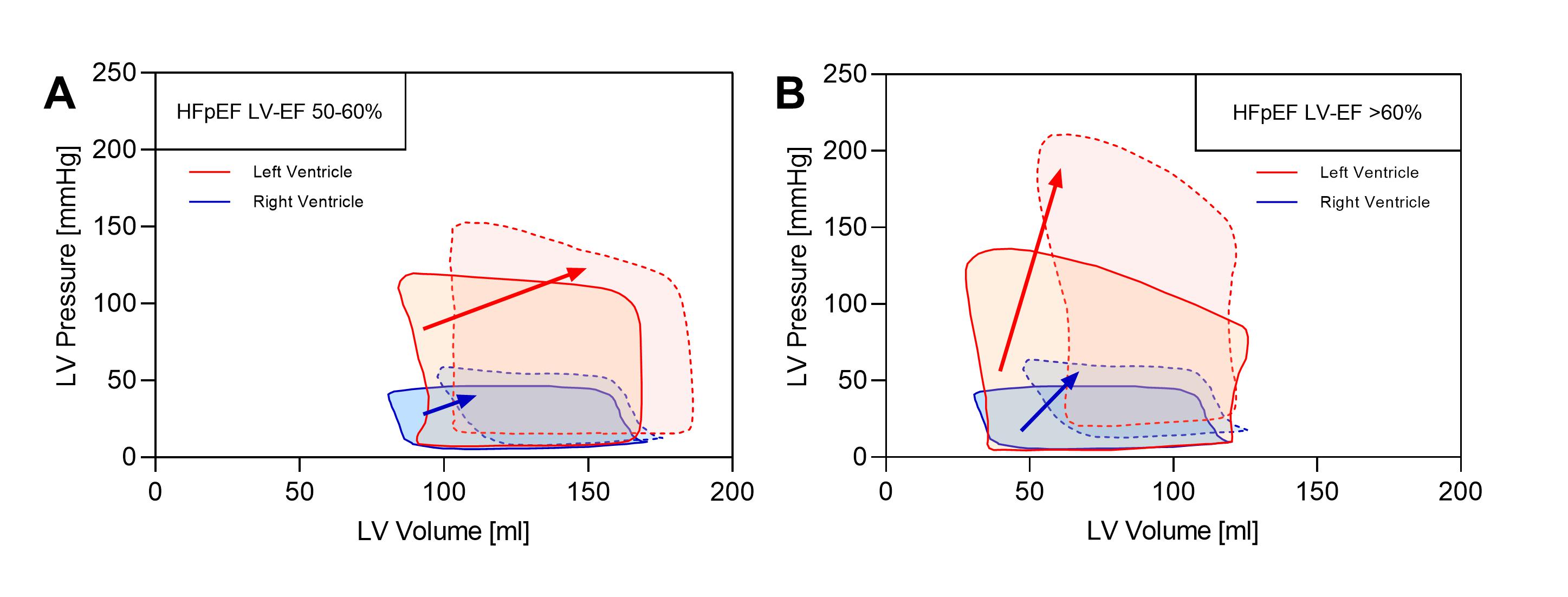AIMS: Detailed evaluation of patients with heart failure with preserved ejection fraction (HFpEF) recently identified two fundamental different hemodynamic phenotypes after grouping patients according to left ventricular (LV) ejection fraction (EF). Key differences were pronounced pre- and afterload sensitivity in LV-EF >60% cohort. It remains unknown whether similar patterns are also seen in the RV and whether LV pressure-volume (PV) relations at rest and during exercise stress in HFpEF can be explained by specific interactions of the RV with the LV.
METHODS: HFpEF patients were grouped into a LV-EF 50-60% and LV-EF >60% cohort. All patients underwent cardiac magnetic resonance imaging prior to hemodynamic characterization. LV and RV were examined sequentially including PV loop analysis to derive advanced indexes of systolic and diastolic ventricular function during preload reduction and handgrip exercise. Load-independent ventricular contractility (systolic stiffness) is reported as LV120i and RV40i respectively, incorporating both, end-systolic elastance and X-axis intercept of the end-systolic PV relationship.
RESULTS: In n=37 HFpEF patients (n=15 LV-EF 50-60% and n=22 LV-EF >60%) sufficient biventricular PV loop data was obtained during preload reduction and afterload increase.
Morphologically, LV-EF >60% cohort had smaller RV end-systolic volume (ESVi, 26.0 vs. 36.5 ml/m², p<0.01), higher RV-EF (62 vs. 50%, p<0.01) and comparable RV stroke volume (SVi, p=0.89) when compared to LV-EF 50-60% cohort. There was vast agreement of LV and RV volumes (end-diastolic volume, EDVi r=0.77, p<0.01; ESVi r=0.54, p<0.01; SVi r=0.95 p<0.01). Contrary to LV, RV filling pressures at rest did not differ between both HFpEF cohorts (p>0.05).
PV loop analysis unmasked higher LV diastolic stiffness in LV-EF >60% cohort (β constant, 0.033 vs. 0.018, p<0.01) while RV diastolic stiffness did not differ between cohorts (p=0.28) at rest. However, exercise stress revealed a comparable upward shift of the PV relations of both ventricles in LV-EF >60% cohort with exaggerating exertional diastolic stiffness (EDP/EDVi ratio) in LV (0.37 vs. 0.28 mmHg/ml/m², p<0.01) and RV (0.18 vs. 0.11 mmHg/ml/m², p=0.03) compared to LV-EF 50-60% cohort. A slight increase (∆) of RV EDVi was observed in both cohorts and did not differ between LV-EF >60% and LV-EF 50-60% cohort (∆EDVi 6.2 vs. 5.2 ml/m², p=0.84).
Systolic stiffness was also higher in LV and RV in LV-EF >60% cohort (p<0.05) at rest. During exercise stress, systolic stiffness further exaggerated with lower LV120i (20.6 vs. 32.0 ml/m², p<0.01) and RV40i (26.4 vs. 41.1, p<0.01) indicating higher biventricular systolic stiffness in LV-EF >60% compared to LV-EF 50-60% cohort.
CONCLUSION: The hemodynamic profiles of LV and RV during exercise stress closely resemble each other with an upward ship of the PV-relations and markedly elevated systolic and diastolic stiffness in LV-EF >60% cohort. Although an additional rightward shift of the RV PV-relation was observed, it was only modest and comparable between HFpEF cohorts. Therefore, RV rightward shift might not explain LV upward shift during exercise stress itself.
Rather, HFpEF a biventricular disease, which should be incorporated in future considerations about pathomechanisms, contributing factors and therapeutic targets.

Figure 1: Schematic biventricular PVloops at baseline (solid) and during handgrip exercise (dashed) in HFpEF with LV-EF 50-60% (A) and LV-EF >60% (B).
https://dgk.org/kongress_programme/jt2023/aP1351.html